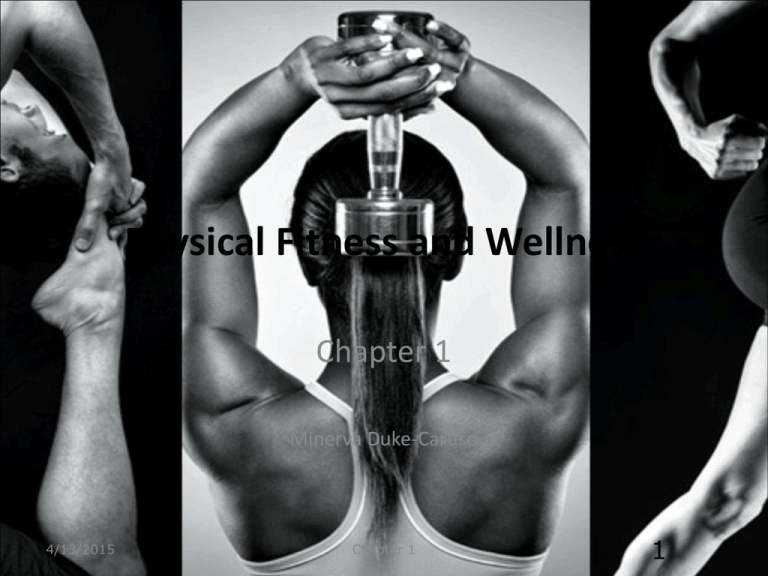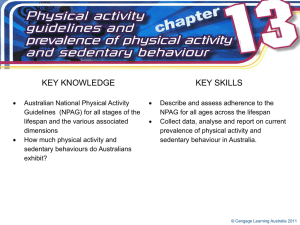LTF_chapter_one - PHYSICAL EDUCATION PROGRAM
advertisement

Physical Fitness and Wellness Chapter 1 Minerva Duke-Caruso 4/13/2015 Chapter 1 1 Student Learning Objectives • Health and fitness consequences from physical inactivity. • Identify health problems in the US. • How to monitor daily physical activity. • Define wellness and list its dimensions. LPFW 2 © Cengage Publishing Continue with SLO’s • Define physical fitness & list health-related, and skill-related. • Differences between physical fitness, health promotion, & wellness. • Difference between health fitness standards and physical fitness standards. LPFW 3 © Cengage Publishing Continue with SLO’s • Benefits from participating in a wellness program. • List National Health Objectives for the year 2020. • Risk factors that may interfere with safe participation in exercise. LPFW 4 © Cengage Publishing Second – greatest threat to public health in US Number 1 4/13/2015 Chapter 1 5 Underlying Causes of Death in the United States, Year 2000 LPFW 6 © Cengage Publishing Chronic disease • Illnesses that develop as a result of? – Inactivity 4/13/2015 7 Lifestyle as a Health Problem • Second greatest threat to public health • Disease is related to: • Your body may be older than you think! 4/13/2015 Chapter 1 8 Hypokinetic • Hypo • Kinetic – • Diseases related 4/13/2015 Chapter 1 9 Chronic disease 4/13/2015 Chapter 1 10 True or False • Research shows that the body deteriorates faster by physical inactivity 4/13/2015 Chapter 1 11 True or False • The Epidemic of Physical Inactivity in the USA is called Pedestrian Death Syndrome (PDS) 4/13/2015 Chapter 1 12 Factors That Affect Health and Well-Being LPFW 13 © Cengage Publishing Leading causes of death in U.S. are largely lifestyle-related LPFW 14 © Cengage Publishing Leading causes of death in U.S. are largely lifestyle-related LPFW 15 © Cengage Publishing The Big “3” Underlying Causes of Death in USA • Are you having problems with any of them? 4/13/2015 Chapter 1 16 What % of lung cancer in USA is caused by tobacco use A. B. C. D. E. 57 67 77 87 97 4/13/2015 Chapter 1 17 Smoking accounts for about __percent of all cancer deaths A. B. C. D. E. 30 40 50 60 70 4/13/2015 Chapter 1 18 True or False • Cardiovascular disease is the second leading cause of death in the USA 4/13/2015 Chapter 1 19 Short Answer • Tobacco is the largest cause of ________________ death in the USA. 4/13/2015 Chapter 1 20 Physical Activity Versus Exercise 4/13/2015 Chapter 1 21 Physical Activity and Exercise Defined • Physical activity • Exercise LPFW 22 © Cengage Publishing Daily Physical Activity Recommendations 4/13/2015 Chapter 1 23 ACSM – American College of Sports Medicine 4/13/2015 24 ACSM • Strength 4/13/2015 25 ACSM Stand for 4/13/2015 Chapter 1 26 The U.S. Surgeon General recommends adults to exercise 4/13/2015 Chapter 1 27 Health Fitness Standards are 4/13/2015 Chapter 1 28 Monitoring Daily Physical Activity • Most U.S. adults are not sufficiently active • Monitor your daily activity LPFW 29 © Cengage Publishing Pedometer 10,000 -12,499 Active 5,000-7,499 Low Active Which one are you? >12,500 Highly Active 4/13/2015 <5,000 Sedentary Lifestyle Chapter 1 7,500 -9,999 Somewhat active 30 Trivia Questions? • Who is more inactive? 4/13/2015 Chapter 1 31 True or False • The general recommendation is to walk 8,000 steps per day 4/13/2015 Chapter 1 32 Group Work • Get together with your Group • Do not Open Textbook 4/13/2015 Chapter 1 33 Health Benefits • Page 21 4/13/2015 Chapter 1 34 In Simple Words • Regular physical activity is linked to: 4/13/2015 Chapter 1 35 Wellness • The constant & deliberate effort to stay healthy & achieve the highest potential for well-being 4/13/2015 Chapter 1 36 Dimensions of Wellness LPFW 37 © Cengage Publishing Physical • Characteristics 4/13/2015 Chapter 1 38 How Physical Are you? –Sedentary lifestyle –Moderate-intensity exercise –Vigorous activity LPFW 39 © Cengage Publishing Emotional • Characteristics 4/13/2015 Chapter 1 40 Mental • Characteristics 4/13/2015 Chapter 1 41 Social • Characteristics 4/13/2015 Chapter 1 42 Environmental • Characteristics 4/13/2015 Chapter 1 43 What are your concerns? 4/13/2015 Chapter 1 44 Occupational • Characteristics 4/13/2015 Chapter 1 45 Spiritual • Characteristics 4/13/2015 Chapter 1 46 Altruism 4/13/2015 Chapter 1 47 Physical Fitness can be classified into 2 areas: 4/13/2015 Chapter 1 48 Health-Related Components of Physical Fitness LPFW 49 © Cengage Publishing Skill-related fitness 4/13/2015 Chapter 1 50 What are they? 4/13/2015 Chapter 1 51 Skill-Related Components of Physical Fitness LPFW 52 © Cengage Publishing Which Program is Best? 4/13/2015 Chapter 1 53 National Health Objectives for the Year 2020 • Healthy People 2020 – Goals • Increase quality and years of healthy life • Eliminate health disparities – Objectives • Personal responsibility • Health benefits for all people • Health promotion and disease preventiohttp://www.healthypeople.gov/2020/default.aspxn LPFW 54 © Cengage Publishing The Wellness Challenge of the 21st Century LPFW 55 © Cengage Publishing Exercise Safety LPFW 56 © Cengage Publishing Your Fitness Goal – Select One 4/13/2015 Chapter 1 57 Goal Paper SMART GOALS Specific Measurable Attainable Realistic Timely 4/13/2015 Chapter 1 58 Group work 1. 2. 3. 4. Select a question, discuss it, present it Explain how the seven dimensions of wellness relate to each other. List 2 steps your group can take to help the environment of your college. Briefly explain, what are the most important habits that your family can change to promote better health in your home. Explain why your group exhibits more healthrelated fitness or skill-related fitness. 4/13/2015 Chapter 1 59






